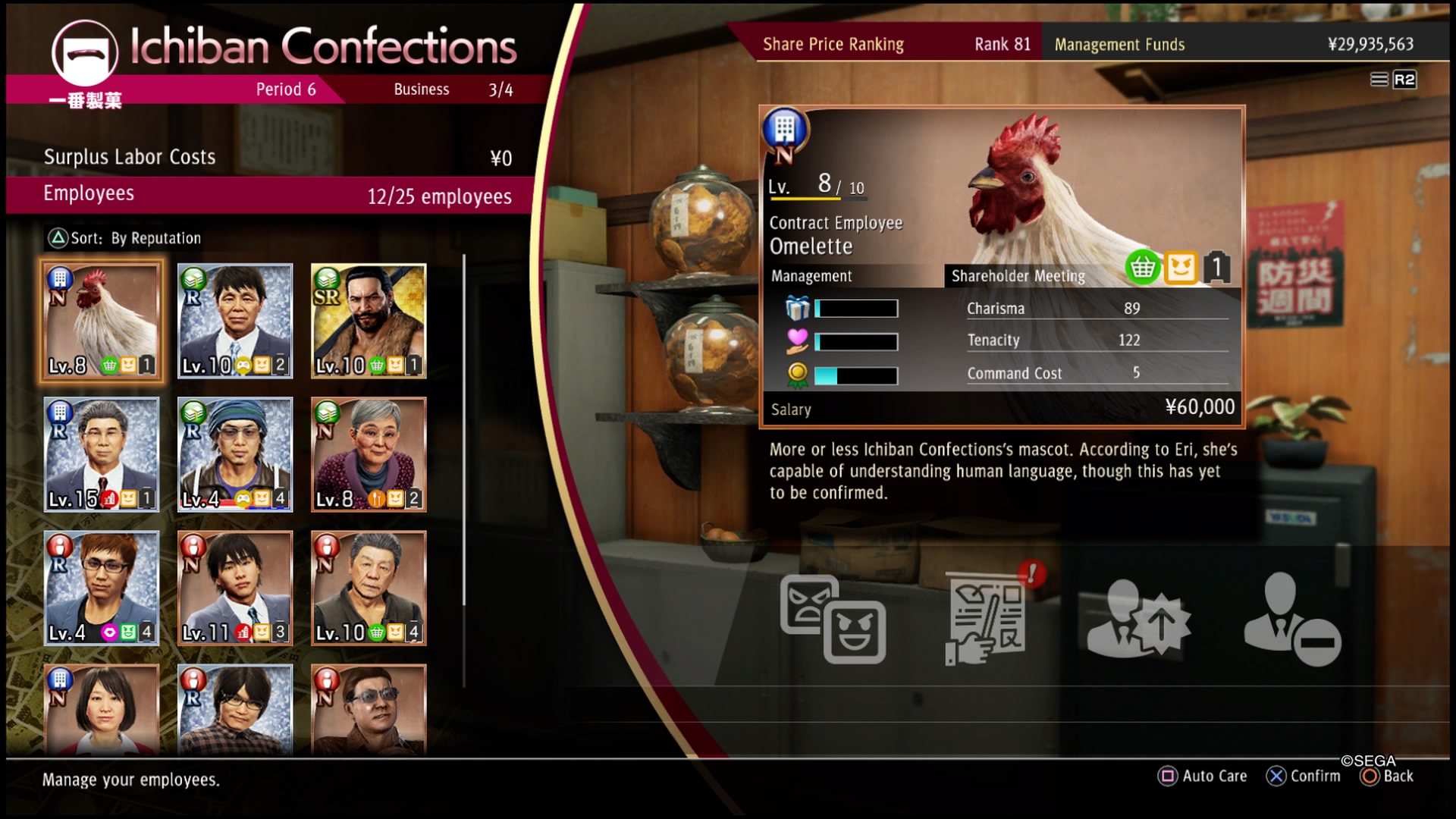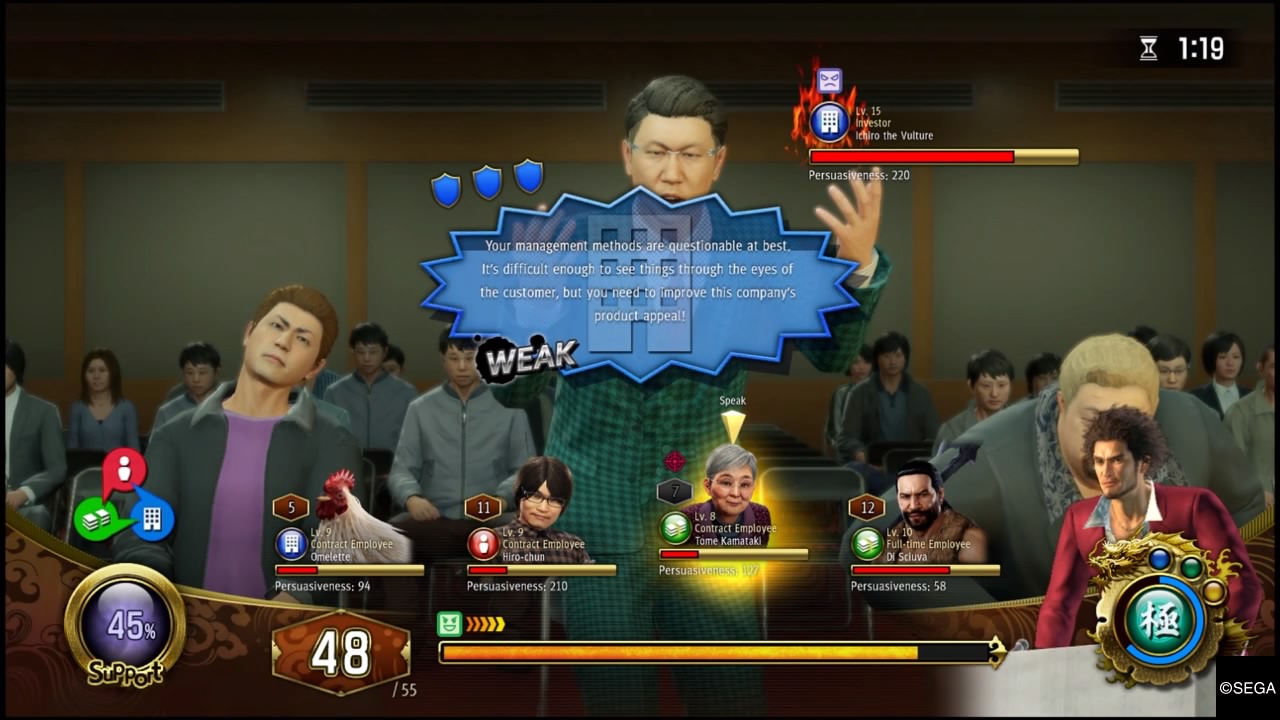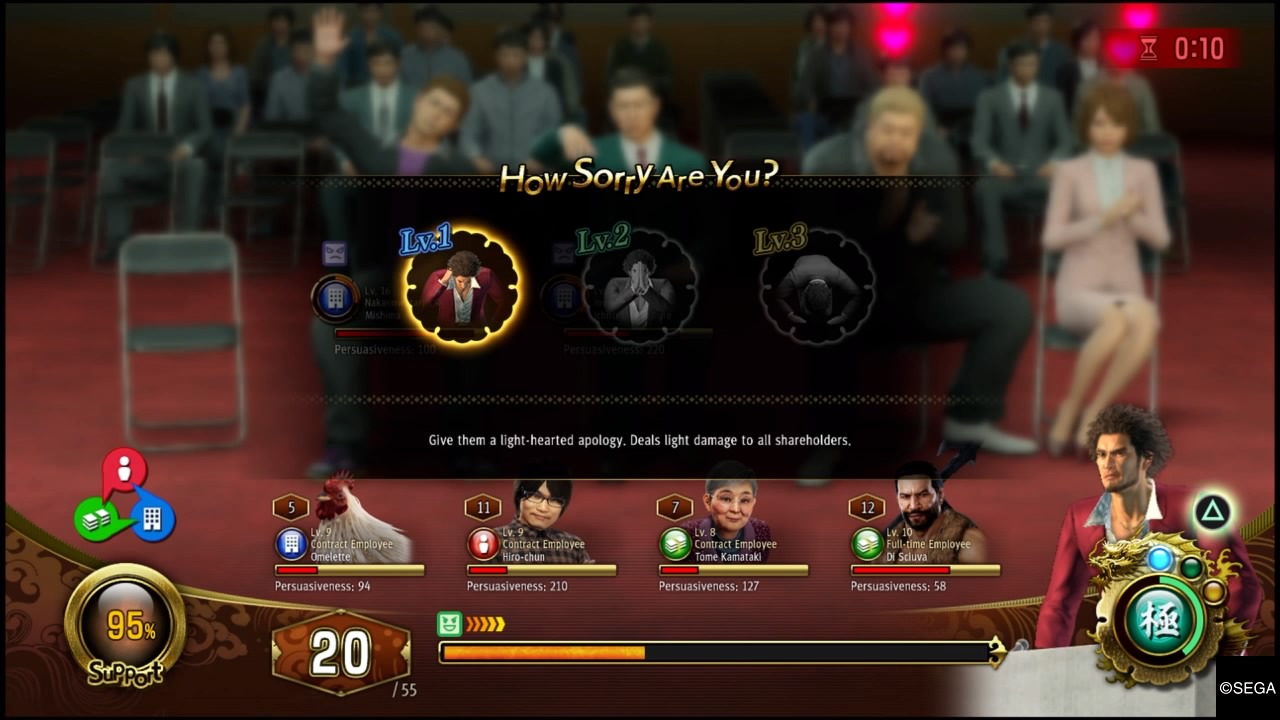Yakuza Like A Dragon Management and Shareholder Meetings explained
Handle shareholders in Yakuza Like A Dragon Business Management

Learn how Yakuza Like A Dragon management works to ace shareholder meetings and make money on the side. It's not a Yakuza game if you aren't running a side hustle, and Ichiban is no different in Yakuza Like A Dragon with his Ichiban Confections business. The goal is to build a rice cracker business, and become the best in Yokohama. You'll also have to upgrade your store, train, and face Shareholder Meetings at the end of every business period. In these meetings you have to convince your sponsors that it's all going well and that you’d love to have their support to continue. If all else fails, however, then you’ve got one other option: saying sorry.
On the surface, this may not seem all that important, but failing a Shareholder Meeting can have severe consequences, such as decreasing your rank in management - terrible if you’re trying to get to the top 100 or 50 before Nick Ogata comes to visit and rids you of your business. It also hurts the morale of your employees, and the reputation of your business. So, if you want to do well at Management - and you'll need to if you want to recruit Emi Kamataki in Yakuza Like A Dragon - you must be ready to talk your way through those meetings. Here's what you need to know about Yakuza Like A Dragon Business Management and Shareholder Meetings.
Getting prepared for Yakuza Like A Dragon Shareholder Meetings
The game tries to explain Shareholder Meetings, but unfortunately is pretty bad at explaining some of the pictures and information it throws at you. For one thing, it doesn’t let you know that while looking at your Management screen, where you can recruit employees and buy property, there’s also the option to look at who you’re going to be up against in your Shareholder Meetings. You should have a look at it before you start your Shareholder Meetings, just so you can analyze your strategy.
Let’s give you an example. Look at the following image:

With this screen you’re able to see that the three shareholders in the upcoming meeting have different colour circles attached to their level. One has blue, one has red, and the other has green. On the left side of the screen, you’ll see the same colours - blue, red, and green. These shareholders are linked to those colours, and will focus on these subjects in the Shareholder Meetings. Blue will be interested in your net worth, red in how you manage your employees, and green in the current sales that you made during the period of business.
These colours aren’t just for showing who cares about what, however. Focus your attention to the top right of the screen and you’ll see a circle that may look similar to previous Yakuza players. For those who have no idea what that circle of mishmashed colours mean, we’ll explain: green beats blue, which beats red, which then beats green. It’s a circle that goes by the formula of rock-paper-scissors, and it’s this method that you’ll need to rely on when having it out with your shareholders. For example, if you have three enemies, with two red circles and one green, you should include blue and red employees as these are best suited for battle.
You can also see that, next to their titles of part-time employee, there is a number that isn’t their level. This is how much power you need to have to ‘play’ the employee in the meeting. As you can see, the total power here is 40, so if I was to play my first employee, I’d be left with a power of 33.
If you look closer, you’ll see that both the boardroom members and employees have a smiling or angry face next to their level. While it isn’t great if your opponent is angry, it’s even worse if your employees are as they won’t perform as well. So the best thing to do before a board meeting is to give your employees some love through treating them to spas or just letting the game do it for you by using Auto-Care in the employee section before you head into the shareholders meeting. The more positive your employees are, the better chance you’ll have in succeeding in the meeting.
Understanding Employee Stats

To pick the best employee to head to ‘battle’ in, you’ll need to know and understand what employee stats are and what they will contribute in the Shareholder Meetings. As you can see, you’ve got stats labelled under the Shareholder Meeting tag - these are the only stats that you’ll need to focus on.
Charisma - This is the employee’s attack power, and can be improved by levelling up your employee. The higher the charisma, the more damage your employee will do in battle.
Tenacity - This is the health of your employee, and like Charisma, can be improved by levelling up your employee.
Command Cost - This is how much power you need in order to choose the employee to argue against the opposing shareholders.
Going to Battle
With all that said and done, it’s time to head to battle and kick those ungrateful sponsors where the sun don’t shine!
In this section of the game, you’ll have to put all the information that you’ve learned from this guide into action. It may sound a little overwhelming at first, but if there’s one tip we can give out to you is that, if you’re struggling throughout the battle, you can hit the pause button and get your breath. It’s helped us out many times!

Onto battle! After the introductory cutscene, you’ll be tasked with answering questions from your sponsors. You can choose which sponsor you’d like to talk to first, but be aware that the longer you wait, the more impatient they’ll get and if you leave them waiting too long… The support meter, and your employee’s health will take a hit. Of course, there’s nothing wrong with waiting, as each second gives you more power, but just don’t wait too long.
From the picture above you’ll notice that the sponsor yelling at us has blue shields above his dialogue box. This is significant as it means that you’ll need a green employee to penetrate the shields and leave the sponsor vulnerable to your attacks. In this image, the sponsor and shield are the same colour, but if you have a sponsor that’s blue but their dialogue box has green shields, use your red employees to break the shields down and then use the green employee to deal damage. It’s a lot of memorizing, which is why we really do suggest pausing if you feel overwhelmed.
You should also take notice of the red bar of the sponsor when you get into an argument with them. That’s their Tenacity, aka health bar, and can only be shortened when their shield is down. We advise you go for the sponsor with the smallest health bar first, as they are much easier to win over and you’ll still have enough power to at least knock some health off the more powerful enemies. After all, you only need your support to be 100% to win the match, not get all of your shareholder sponsors on your side. It’s best to have more than just one.
If you’re struggling with waiting on power, leaving room for your enemies to tear into your support, there is only one option...
Saying sorry

At the bottom right hand corner you’ll see a ring with three, smaller rings above it. This is your ‘sorry’ button, and pressing it will give you the option of making Ichiban apologize. You have three levels of ‘sorry’ which range from stunning your enemies to knocking their health down to 0 if you use it at the right moment. It is incredibly helpful, and can be used to tactically beat your enemies in battle.
Now that you know everything you need to in order to win the Shareholder Meeting battles, go out there and prove to everyone that Ichiban is the best business manager in the world!
Weekly digests, tales from the communities you love, and more

Aimee Hart is an editor and award-winning writer with a prolific background in copywriting, creative fiction, and freelance reporting and has been in the writing space for over 7 years. When she isn't caring far too much about fictional characters and worlds, she's narrating her own with friends.


